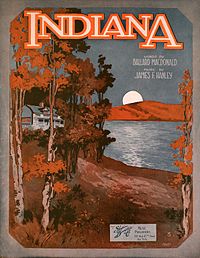Back Home Again in Indiana
(Back Home Again in) Indiana is a song composed by Ballard MacDonald (lyrics) and James F. Hanley (music), and was first released in January 1917. Although not the official anthem of the US state , it is arguably the best-known song associated with Indiana . After its release, it became the jazz standard and covered by many interpreters across all styles .
History of origin
The genesis of the song begins with Paul Dresser (1858–1906), older brother of the writer Theodore Dreiser . He had his biggest hit with On the Banks of the Wabash in 1897 , Far Away , which the Indiana government adopted as an anthem in 1913. The song by Ballard MacDonald and James F. Hanley, written four years later, was so closely based on the popular Tin Pan Alley song Dressers in terms of music and lyrics that his brother wanted to initiate a plagiarism lawsuit after Dresser's death (which the publishers because Hanley and MacDonald had only received permission from the publisher to take over a few bars. Indiana borrowed the lines On the Banks of the Wabash, Far Away , as well as other keywords such as moonlight, candlelight, fields, new-mown hay, sycamores and Wabash River from the original song .
The 32-bar melody of the song is written in the song form A1-B-A2-C; the song is interpreted at a moderately fast to fast tempo.
Use of the song in car racing in Indianapolis
The performance of the song Back Home Again in Indiana is a highlight in the annual preparations for the Indianapolis 500 car race, especially since 1972 with the singing of Jim Nabors . This tradition began in 1946 with tenor James Melton; other well-known vocalists were Dinah Shore , Dennis Morgan , Mel Tormé , Vic Damone , Ed Ames and Peter DePaolo .
Back Home Again in Indiana as the jazz standard
(Back Home Again in) Indiana was a popular daily hit as early as 1917 and subsequently became a widely played jazz standard . For Columbia Records he took on January 30, 1917, the Original Dixieland Jazz Band ; this was one of the first and well-selling early jazz records. For many decades the song was part of the repertoire of Louis Armstrong , who opened his gigs with the number.
On April 18, 1929, Red Nichols took him on with his five pennies for Brunswick ; this version reached # 19 on the charts in October 1929. In the swing era , the song was a popular number for jam sessions ; he was u. a. by many musicians this time, such as Sidney Bechet , Count Basie , Roy Eldridge , Coleman Hawkins to Art Tatum and Lester Young recorded. Based on Indiana , Charlie Parker wrote his composition Donna Lee in 1947 with Miles Davis as bebop head . Further revisions of the theme in modern jazz came from Fats Navarro (Ice Freezes Red) and Lennie Tristano (JuJu). Indiana was also interpreted in the post-war period by Charlie Parker, Erroll Garner , Kay Thompson , Dave Brubeck , Oscar Peterson René Thomas , and later by Rosemary Clooney , Oskar Klein , Joey DeFrancesco and Gary Burton .
Use in film
1940 (Back Home Again in) Indiana is played and sung by a dance band in the film Remember the Night at the request of the leading actor. In 1952, the song was used in Walter Lang's biography With A Song in My Heart , where actress Susan Hayward was doubled vocal by Jane Froman. In 1959, the song was included in the musical film The Gene Krupa Story and in the Red Nichols biopic The Five Pennies . The song was later found in the sports film Frei Throw (1986) and in the Woody Allen film Sweet and Lowdown (1999), in which the version of Red Nichols was played.
literature
- Carlo Bohländer (Ed.): Reclams Jazzführer . Edition in 2 volumes (personal and material part) 1977 (Reclam) / 1980 (Ed.Peters, Leipzig)
Web links
- Lyrics and sheet music at Wikisource
- Inclusion in the catalog of the German National Library: DNB 359119190
- Back Home Again in Indiana at Jazzstandards.com
Remarks
- ↑ James Frederick Hanley (born February 17, 1892 in Rensselaer; † February 8, 1942) was a member of the New York Tin Pan Alley music scene. He wrote hits for Broadway musicals such as Second Hand Rose (lyrics: Grant Clarke) for Fanny Brice (1921 Ziegfeld Follies ) and Zing! Went the Strings of My Heart (1934), made famous by Judy Garland in 1938. In the early 1930s he also composed for numerous Hollywood musicals
- ↑ In the Five Pennies during this session u. a. Glenn Miller , Benny Goodman , Manny Klein , Karl Kress , Gene Krupa , Babe Russin , Arthur Schutt and Jack Teagarden
- ↑ Lester Young played him a. a. 1942 in a trio with Nat Cole and Red Callender ; heard on The Complete Aladdin Sessions
- ↑ Oscar Peterson played him in a quartet with Lester Young in 1952, to be heard on the album Lester Young with the Oscar Peterson Trio .
Individual evidence
- ↑ Memorial stones for James Frederick Hanley
- ↑ a b c d e Back Home Again in Indiana at Jazzstandards.com
- ↑ a b c Cf. Carlo Bohländer, p. 215.
- ↑ See Joel Whitburn: Pop Memories 1890-1954. Record Research Inc., Menomone Falls (Wisconsin) 1986. Cf. Gerhard Klußmeier : Jazz in the Charts. P. 9.
